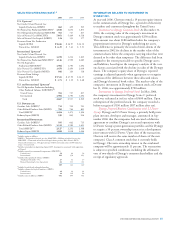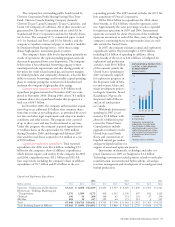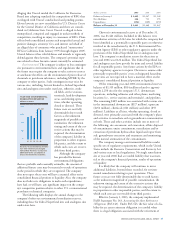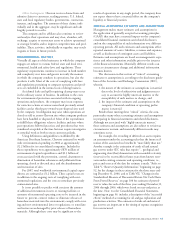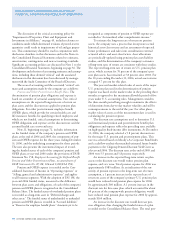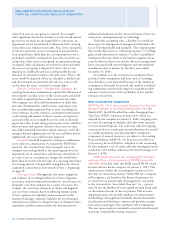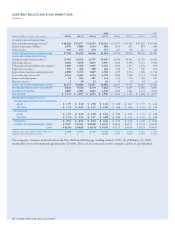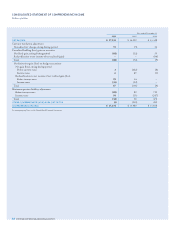Chevron 2006 Annual Report Download - page 46
Download and view the complete annual report
Please find page 46 of the 2006 Chevron annual report below. You can navigate through the pages in the report by either clicking on the pages listed below, or by using the keyword search tool below to find specific information within the annual report.
MANAGEMENT’S DISCUSSION AND ANALYSIS OF
FINANCIAL CONDITION AND RESULTS OF OPERATIONS
44 CHEVRON CORPORATION 2006 ANNUAL REPORT
The discussion of the critical accounting policy for
“Impairment of Properties, Plant and Equipment and
Investments in Affi liates,” on page 45, includes reference to
conditions under which downward revisions of proved-reserve
quantities could result in impairments of oil and gas proper-
ties. This commentary should be read in conjunction with
disclosures elsewhere in this discussion and in the Notes to
the Consolidated Financial Statements related to estimates,
uncertainties, contingencies and new accounting standards.
Signifi cant accounting policies are discussed in Note 1 to the
Consolidated Financial Statements, beginning on page 56. The
development and selection of accounting estimates and assump-
tions, including those deemed “critical,” and the associated
disclosures in this discussion have been discussed by manage-
ment with the Audit Committee of the Board of Directors.
The areas of accounting and the associated “critical” esti-
mates and assumptions made by the company are as follows:
Pension and Other Postretirement Benefi t Plans The
determination of pension plan obligations and expense is
based on a number of actuarial assumptions. Two critical
assumptions are the expected long-term rate of return on
plan assets and the discount rate applied to pension plan
obligations. For other postretirement employee benefi t
(OPEB) plans, which provide for certain health care and
life insurance benefi ts for qualifying retired employees and
which are not funded, critical assumptions in determining
OPEB obligations and expense are the discount rate and the
assumed health care cost-trend rates.
Note 21, beginning on page 72, includes information
on the funded status of the company’s pension and OPEB
plans at the end of 2006 and 2005, the components of pen-
sion and OPEB expense for the three years ending December
31, 2006, and the underlying assumptions for those periods.
The note also presents the incremental impact of record-
ing the funded status of each of the company’s pension and
OPEB plans at year-end 2006 under the provisions of FASB
Statement No. 158, Employers’ Accounting for Defi ned Benefi t
Pension and Other Postretirement Plans, an amendment of
FASB Statements No. 87, 88, 106 and 132R (FAS 158).
Pension and OPEB expense is recorded on the Con-
solidated Statement of Income in “Operating expenses” or
“Selling, general and administrative expenses” and applies
to all business segments. With the adoption of FAS 158, the
year-end 2006 funded status, measured as the difference
between plan assets and obligations, of each of the company’s
pension and OPEB plans is recognized on the Consolidated
Balance Sheet. The funded status of overfunded pension plans
is recorded as a long-term asset in “Deferred charges and
other assets.” The funded status of underfunded or unfunded
pension and OPEB plans is recorded in “Accrued liabilities”
or “Reserves for employee benefi t plans.” Amounts yet to be
recognized as components of pension or OPEB expense are
recorded in “Accumulated other comprehensive income.”
To estimate the long-term rate of return on pension
assets, the company uses a process that incorporates actual
historical asset-class returns and an assessment of expected
future performance and takes into consideration external
actuarial advice and asset-class factors. Asset allocations
are periodically updated using pension plan asset/liability
studies, and the determination of the company’s estimates
of long-term rates of return are consistent with these studies.
The expected long-term rate of return on U.S. pension plan
assets, which account for 70 percent of the company’s pen-
sion plan assets, has remained at 7.8 percent since 2002. For
the 10 years ending December 31, 2006, actual asset returns
averaged 9.7 percent for this plan.
The year-end market-related value of assets of the major
U.S. pension plan used in the determination of pension
expense was based on the market value in the preceding three
months as opposed to the maximum allowable period of fi ve
years under U.S. accounting rules. Management considers
the three-month period long enough to minimize the effects
of distortions from day-to-day market volatility and still be
contemporaneous to the end of the year. For other plans,
market value of assets as of the measurement date is used in
calculating the pension expense.
The discount rate assumptions used to determine U.S.
and international pension and postretirement benefi t plan
obligations and expense refl ect the prevailing rates available
on high-quality fi xed-income debt instruments. At December
31, 2006, the company selected a 5.8 percent discount rate
for the major U.S. pension and postretirement plans. This
rate was selected based on Moody’s Aa Corporate Bond Index
and a cash fl ow analysis that matched estimated future benefi t
payments to the Citigroup Pension Discount Yield Curve as
of year-end 2006. The discount rates at the end of 2005 and
2004 were 5.5 percent and 5.8 percent, respectively.
An increase in the expected long-term return on plan
assets or the discount rate would reduce pension plan
expense, and vice versa. Total pension expense for 2006 was
approximately $585 million. As an indication of the sen-
sitivity of pension expense to the long-term rate of return
assumption, a 1 percent increase in the expected rate of
return on assets of the company’s primary U.S. pension plan
would have reduced total pension plan expense for 2006
by approximately $60 million. A 1 percent increase in the
discount rate for this same plan, which accounted for about
60 percent of the companywide pension obligation, would
have reduced total pension plan expense for 2006 by approxi-
mately $160 million.
An increase in the discount rate would decrease pen-
sion obligation, thus changing the funded status of a plan
recorded on the Consolidated Balance Sheet. The total pen-



